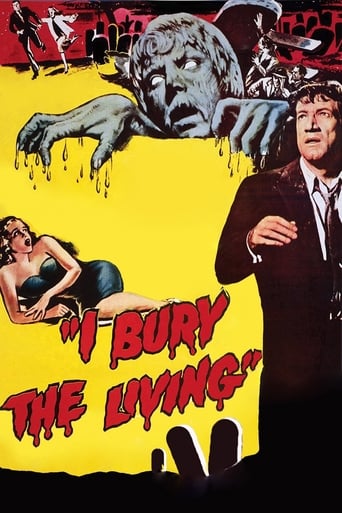



How sad is this?
Crappy film
The acting is good, and the firecracker script has some excellent ideas.
View MoreIt is encouraging that the film ends so strongly.Otherwise, it wouldn't have been a particularly memorable film
View MoreBusinessman Robert Kraft (a solid and credible performance by Richard Boone) becomes the newly elected director of a cemetery. Kraft discovers that he can cause the deaths of living owners of funeral plots by simply changing the push-pin color from white to black on a large wall map of the graveyard. Director Albert Band, working from a creative and compelling script by Louis Garfinkle, relates the offbeat and fascinating story at a steady pace, offers a flavorsome evocation of the rural region and the people who populate the area, makes good use of the depressing boneyard location, generates a good deal of tension, and does a bang-up job of crafting an eerie and unsettling gloom-doom atmosphere which gets especially spooky in the last third before alas faltering with a lame cop-out "realistic" final explanation. Moreover, the freshness and originality of the central premise along with several inspired visual flourishes kicks up the overall quality of this picture a few extra notches. The fine acting by the able cast rates as another definite asset: Theodore Bikel easily steals the whole show with his gloriously hammy portrayal of hale'n'hearty grounds keeper Andy McKee, Peggy Mauper radiates a sweet charm as Kraft's concerned fiancé Ann Craig, plus there are sturdy contributions from Howard Smith as the jolly George Kraft, Herbert Anderson as skeptical reporter Jess Jessup, and Robert Osterloh as the cynical Lt. Clayborne. Frederick Gately's sharp cinematography makes cool use of fades and dissolves. Gerald Fried's robust score hits the spirited shivery spot. Worth a watch.
View MoreRichard Boone plays Robert Kraft, the newly elected director of a cemetery who finds himself involved in a morbid mystery when people who have plots in the cemetery begin mysteriously dying, especially when Robert realizes that he mistakenly put a black pin(for dead) in place of a white pin(for living) on a big map representing all the burial plots in the cemetery, for people who subsequently died. This doesn't seem to be a coincidence, since every time he does it, someone else dies... Can Robert stop this jinx, or is something else going on here? Theodore Bikel costars as the retiring caretaker Andy McKee. Despite a good score and direction, this film is ruined by the revelation at the end, which is simply not credible, as if it was thought of at the last minute. Too bad, because this could have been good.
View MoreA local businessman is obliged to become a cemetery's director and subsequently discovers that by prematurely pinning a map for reserved graves, the new proprietors soon mysteriously wind up dead somehow. At first his claims are not believed but presently he is tested by various interested parties. Eventually, the guilt gets to him and he comes close to a complete nervous breakdown. However, it ends with finding out he was not responsible for the deaths and that his caretaker was behind it all along. There are some misleading aspects to this film, such as the title implies people are being buried alive. This, sadly, is not the case! Also, even though the overall body-count is significant you only see one man having a heart attack, all the other victims are off-screen. This is counter-productive to the movie's final twist, as it it proves the caretaker could not be blamed for all of the deaths. The ending is therefore confusing and appears nonsensical.This movie is slow-paced and takes what feels like an age to reveal anything relevant. Seeing the same shot of the map, repeated over and over, only emphasises how monotonous the pacing actually is. Despite all it's problems, this movie still manages a modicum of entertainment. As others have observed, it feels like an extended episode of classic 'Twilight Zone', and would have possibly fared better in this shorter format. Richard Boone's performance, although not award winning, still convinces as his paranoia grows. And we are rewarded with an interesting visual segment, where psychedelic imagery is employed to project Boone's hysterical hallucinations.'I Bury the Living' is not a classic horror - or a horror or a classic, for that matter! What it is a clunky yet amusing title, written in a very 'Amazing Tales' sort of way that would appeal to fans of these kind of old mysteries.
View MoreOn a map of the graveyard on the wall, black pins mean the plot is already "occupied", shall we say. White pins mean the plot is sold, but not occupied. For a laugh one night, the newly appointed cemetery caretaker sticks a black pin into an unoccupied plot. When its owner dies .....Believing it to be coincidental, he does it again: he sticks a black pin into a random unoccupied plot on the map, belonging to W. Isham. We are then introduced to Isham, as he is sticking pins into a stuffed teddy bear, sewing it back together. Creepy, he seems to enjoy it a bit too much, even creepier is when Isham drops dead immediately after that. Surreal images, and tilted and swirling camera-work show the pressure getting to Boone's character, he starts to blame himself for the deaths, and wonders how he can make amends. He decides to remove the black pins and replace them with the white ones.Big mistake.Lack of special effects require the film to focus more on lighting and mood. Zero-budget sets actually help the film, they make the film seem like it could be taking place in any small town, and give the movie a more gritty look. Unique plot hadn't really been done before, or since. This movie is something like The Twilight Zone meets Alfred Hitchcock, harmed only by its ridiculous, cop-out ending, marring an otherwise first class horror.
View More